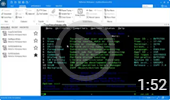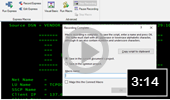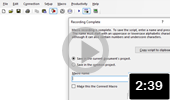Creating and Using Macros
In Reflection, you can create and run macros to simplify and automate routine tasks. You can create two types of macros:
-
Visual Basic for Applications (VBA) macros Create VBA macros when you want to interact with multiple sessions or external applications, such as Microsoft Excel. You can record VBA macros or create them in the Visual Basic editor. You don't need to know how to program to record and playback a macro but recorded macros have limitations (for example, you cannot record interaction with other applications or Web sites).
To create complex macros that perform Reflection actions and interact with other applications, you'll need to use the Visual Basic Editor. A common approach for creating a macro is to record it and then fine-tune it using the editor. For more information about editing and programming macros, see the Reflection VBA Guide ( Help > VBA Guide ).
-
Express Macro Language (EML) macros Create an Express macro when you need to automate basic tasks but are not familiar with programming or when you want to run the macro in other Open Text products. Express macros can be used to automate basic tasks that apply to only one session. They cannot interact with other sessions or external applications. After you create and save an Express macro, you can run it in other Open Text products.
You do not need to know anything about programming syntax to create an Express macro. You can record macros or you can use the Express visual programming editor. Using this editor, you can create or edit macros by arranging graphical elements that represent code blocks rather than specifying them textually.
You can also run macros created in other products, such as Extra!, Rumba, IBM Personal Communications, Brandon Systems Jolly Giant, and Hummingbird.
Videos
 Use the Macro Panel
Use the Macro Panel  Record a Macro
Record a Macro  Record a Macro in Classic Mode
Record a Macro in Classic Mode  Running Extra! Macros
Running Extra! Macros
More information